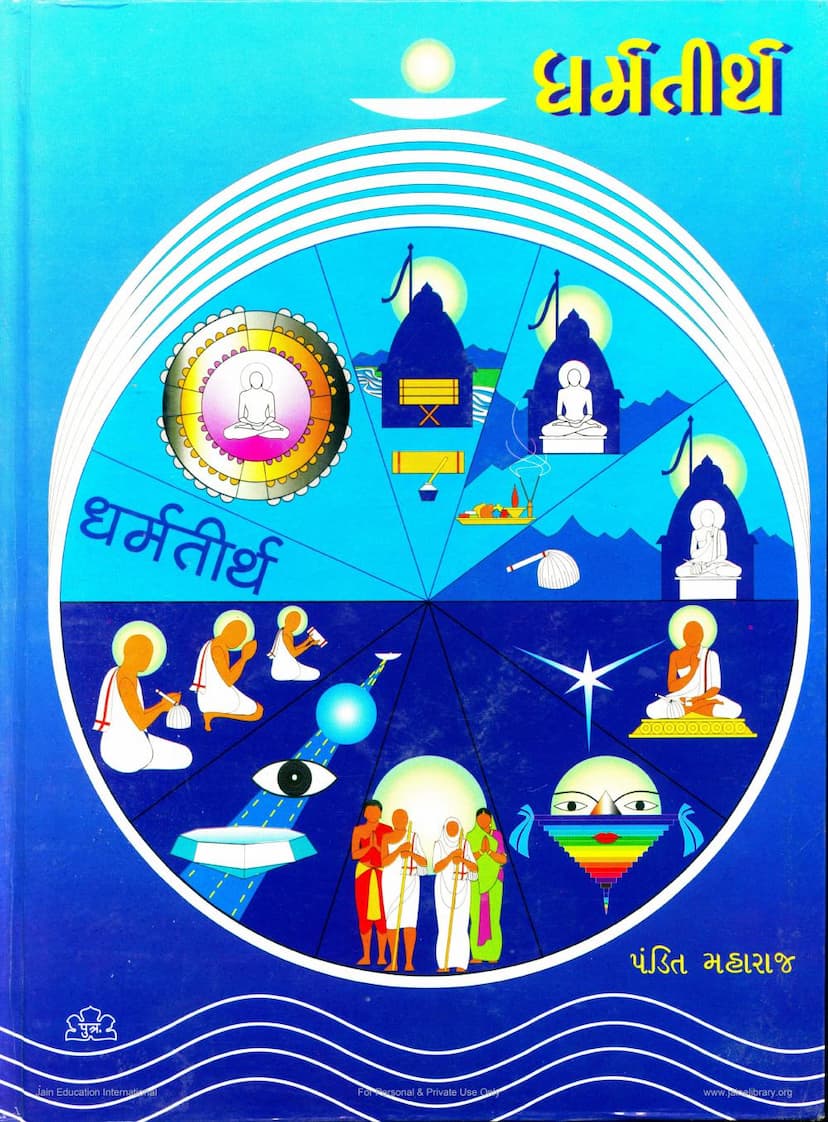Dharmtirth Part 01
Added to library: September 1, 2025

Summary
Certainly, here's a summary of "Dharmtirth Part 01" by Yugbhushanvijay, based on the provided text:
Book Title: Dharmtirth Part 01 Author: Yugbhushanvijay Publisher: Gangotri Granthmala
This book, "Dharmtirth Part 01," is a significant Jain text authored by Yugbhushanvijay and published by Gangotri Granthmala. The text delves deeply into the concept of "Dharmtirth" (the path or refuge of Dharma), exploring its essence, significance, and the role of various individuals and scriptures in its propagation.
Key Themes and Content:
The book is a comprehensive discourse on the meaning and importance of "Dharmtirth" within Jainism. It aims to elucidate the profound teachings of Jainism by drawing upon a vast array of ancient Jain scriptures and the wisdom of revered Acharyas and Muni Bhagwants.
Foundational Principles and Spiritual Lineage:
- The text is dedicated to the spiritual lineage of prominent Jain Acharyas, starting from Acharya Shrimad Vijay Premsurishwarji Maharaj, then Acharya Shrimad Vijay Ramchandra Surishwarji Maharaj, followed by Muni Pravar Shri Mohjitvijayji Maharaj (Mota Pandit Maharaj), and finally the author, Ganivarya Shri Yugbhushanvijayji Maharaj (Nana Pandit Maharaj). This highlights the authoritative and traditional foundation of the teachings presented.
The Core Concept of Dharmtirth:
- The central theme revolves around "Dharmtirth" itself, which is described as the ultimate refuge for souls in the cycle of birth and death.
- The text emphasizes that Dharmtirth is not merely a physical place but a profound spiritual concept, encompassing pure Dharma, the teachings of the Tirthankaras, and the path to liberation.
- The author highlights the profound contribution of Tirthankaras in establishing and propagating this Dharmtirth, deeming it their highest duty and greatest act of universal benevolence.
Exploration of Jain Philosophy:
- Nishkepa (Categories of Thought): The book likely uses the Jain philosophical framework of Nishkepa (Name, Establishment, Substance, and State) to analyze "Dharmtirth" from multiple perspectives, as indicated by the detailed explanation of the cover page's symbolism.
- The Essence of Dharma: The text explores the multifaceted meaning of "Dharma," tracing its etymological roots and offering broad definitions that encompass right conduct, virtuous thoughts, and spiritual well-being. It emphasizes that true Dharma is aligned with Jinagamsa (the teachings of the Jinas).
- The Living Tirth (Jivanta Tirth): A significant portion of the book is dedicated to understanding "Jivanta Tirth" (Living Tirth). This concept is elaborated through:
- The Guru: The paramount importance of the "geetarth" (one who understands the meaning of scriptures) Guru is stressed as the first living Tirth. Their guidance is essential for navigating the path of Dharma.
- The Twelve Angas (Dwadashangi): The sacred Jain scriptures, the Dwadashangi, are presented as the second living Tirth, holding the essence of eternal truth and the key to spiritual liberation. The text emphasizes the profound depth and immutability of these scriptures.
- The Chaturvidh Sangh: The collective body of monks (Sadhus), nuns (Sadhvis), laymen (Shravaks), and laywomen (Shravikas) is recognized as the third living Tirth. The book explains the structure and significance of the Sangh, highlighting its collective power and role in propagating Jainism.
Key Arguments and Insights:
- Tirthankaras and Dharmtirth: The text explains that Tirthankaras establish Dharmtirth not for their own benefit but for the welfare of the world. Even the Tirthankaras themselves bow to the Dharmtirth, acknowledging its supreme importance.
- The Supreme Importance of Dharmtirth: It is argued that Dharmtirth is considered more venerable than the Tirthankaras themselves, as it is the seed from which Tirthankaras emerge and the means by which even they achieve liberation.
- Theological Distinctions: The book touches upon the distinctiveness of theistic concepts in Jainism compared to other religions, emphasizing the Tirthankaras' liberated state and their detached approach to establishing Dharmtirth.
- The Ideal of "Aajna" (Commandment): The ultimate definition of Dharma is presented as adhering to the commandments of the Jinas ("Aajna"). This underscores the importance of following the path laid out by the enlightened ones.
- The Interconnectedness of Practices: The text likely emphasizes that true spiritual progress comes from the harmonious integration of knowledge (Achar), conduct (Siddhant), and correct understanding (Naya), all guided by Jinagamsa.
Structure and Content Highlights:
- Praise and Reverence: The book begins with reverential invocations and dedications to the spiritual gurus and patrons, reflecting the deep respect within Jain tradition.
- Detailed Explanation of Concepts: It systematically breaks down complex Jain philosophical concepts, likely using the established interpretive tools of Jain logic and commentary.
- Emphasis on Spiritual Practice: While the text covers philosophical and scriptural aspects, it consistently points towards the practical application of Dharma for the well-being of the soul and the universe.
In essence, "Dharmtirth Part 01" is a scholarly and devotional work that aims to provide a comprehensive understanding of the vital Jain concept of Dharmtirth, highlighting its multifaceted nature and its central role in the path to spiritual liberation. It serves as a guide to understanding the core principles and practices that uphold the Jain tradition, rooted in the teachings of the Tirthankaras and elaborated by esteemed Acharyas.